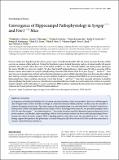| dc.contributor.author | Barnes, S. A. | |
| dc.contributor.author | Wijetunge, L. S. | |
| dc.contributor.author | Jackson, A. D. | |
| dc.contributor.author | Katsanevaki, D. | |
| dc.contributor.author | Osterweil, E. K. | |
| dc.contributor.author | Komiyama, N. H. | |
| dc.contributor.author | Grant, S. G. N. | |
| dc.contributor.author | Nagerl, U. V. | |
| dc.contributor.author | Kind, P. C. | |
| dc.contributor.author | Wyllie, D. J. A. | |
| dc.contributor.author | Bear, Mark | |
| dc.date.accessioned | 2017-05-12T22:57:55Z | |
| dc.date.available | 2017-05-12T22:57:55Z | |
| dc.date.issued | 2015-11 | |
| dc.identifier.issn | 0270-6474 | |
| dc.identifier.issn | 1529-2401 | |
| dc.identifier.uri | http://hdl.handle.net/1721.1/109066 | |
| dc.description.abstract | Previous studies have hypothesized that diverse genetic causes of intellectual disability (ID) and autism spectrum disorders (ASDs) converge on common cellular pathways. Testing this hypothesis requires detailed phenotypic analyses of animal models with genetic mutations that accurately reflect those seen in the human condition (i.e., have structural validity) and which produce phenotypes that mirror ID/ASDs (i.e., have face validity). We show that SynGAP haploinsufficiency, which causes ID with co-occurring ASD in humans, mimics and occludes the synaptic pathophysiology associated with deletion of the Fmr1 gene. Syngap[superscript +/−] and Fmr1[superscript −/y] mice show increases in basal protein synthesis and metabotropic glutamate receptor (mGluR)-dependent long-term depression that, unlike in their wild-type controls, is independent of new protein synthesis. Basal levels of phosphorylated ERK1/2 are also elevated in Syngap[superscript +/−] hippocampal slices. Super-resolution microscopy reveals that Syngap[superscript +/−] and Fmr1[superscript −/y] mice show nanoscale alterations in dendritic spine morphology that predict an increase in biochemical compartmentalization. Finally, increased basal protein synthesis is rescued by negative regulators of the mGlu subtype 5 receptor and the Ras–ERK1/2 pathway, indicating that therapeutic interventions for fragile X syndrome may benefit patients with SYNGAP1 haploinsufficiency. | en_US |
| dc.language.iso | en_US | |
| dc.publisher | Society for Neuroscience | en_US |
| dc.relation.isversionof | http://dx.doi.org/10.1523/jneurosci.1087-15.2015 | en_US |
| dc.rights | Creative Commons Attribution | en_US |
| dc.rights.uri | http://creativecommons.org/licenses/by/4.0/ | en_US |
| dc.source | Society for Neuroscience | en_US |
| dc.title | Convergence of Hippocampal Pathophysiology in Syngap[superscript +/-] and Fmr1[superscript -/y] Mice | en_US |
| dc.title.alternative | Convergence of Hippocampal Pathophysiology in Syngap+/- and Fmr1-/y Mice | en_US |
| dc.type | Article | en_US |
| dc.identifier.citation | Barnes, S. A. et al. “Convergence of Hippocampal Pathophysiology in Syngap+/- and Fmr1-/Y Mice.” Journal of Neuroscience 35.45 (2015): 15073–15081. | en_US |
| dc.contributor.department | Massachusetts Institute of Technology. Department of Brain and Cognitive Sciences | en_US |
| dc.contributor.department | Picower Institute for Learning and Memory | en_US |
| dc.contributor.mitauthor | Bear, Mark | |
| dc.relation.journal | Journal of Neuroscience | en_US |
| dc.eprint.version | Final published version | en_US |
| dc.type.uri | http://purl.org/eprint/type/JournalArticle | en_US |
| eprint.status | http://purl.org/eprint/status/PeerReviewed | en_US |
| dspace.orderedauthors | Barnes, S. A.; Wijetunge, L. S.; Jackson, A. D.; Katsanevaki, D.; Osterweil, E. K.; Komiyama, N. H.; Grant, S. G. N.; Bear, M. F.; Nagerl, U. V.; Kind, P. C.; Wyllie, D. J. A. | en_US |
| dspace.embargo.terms | N | en_US |
| mit.license | PUBLISHER_CC | en_US |
| mit.metadata.status | Complete | |
